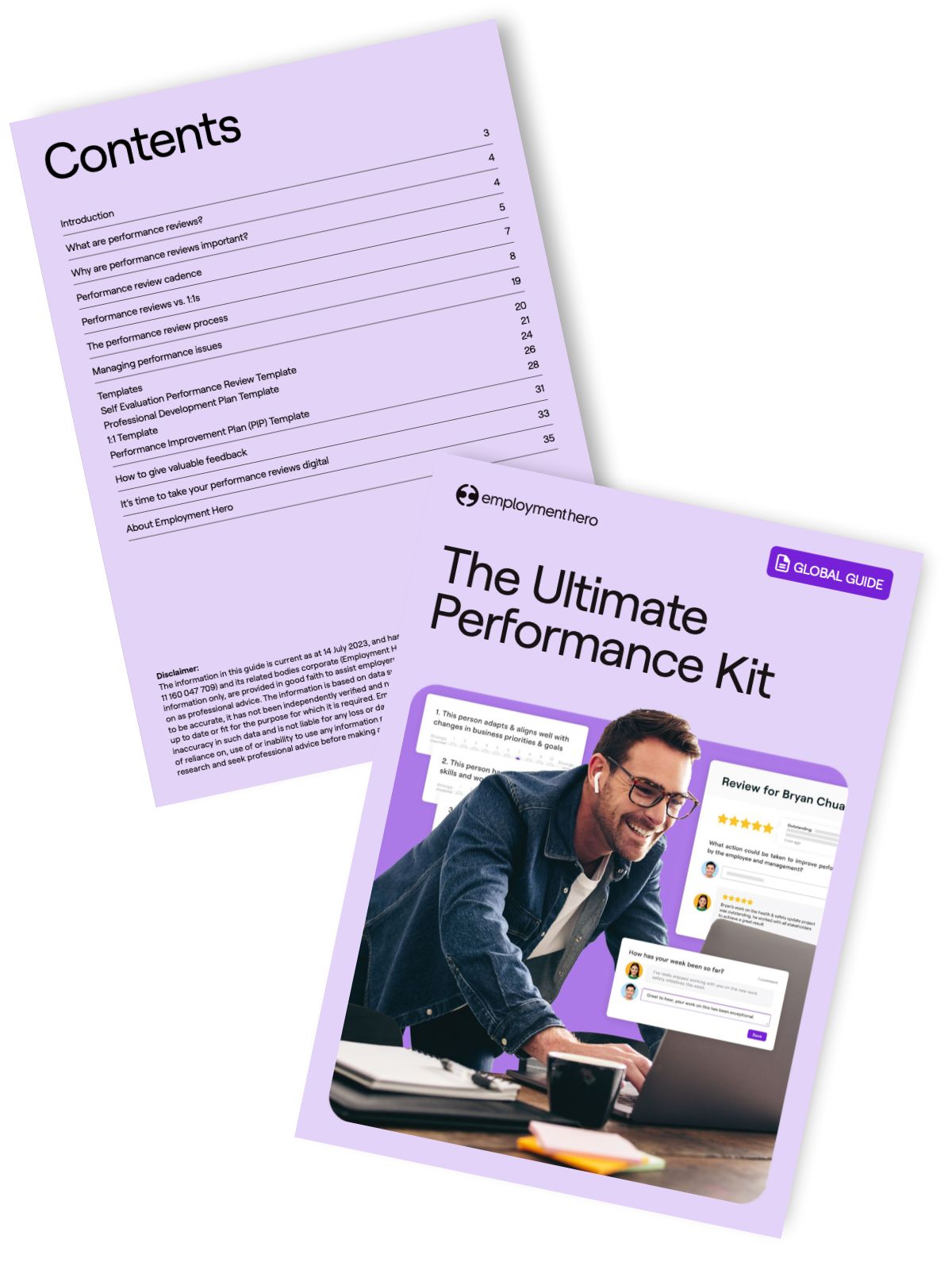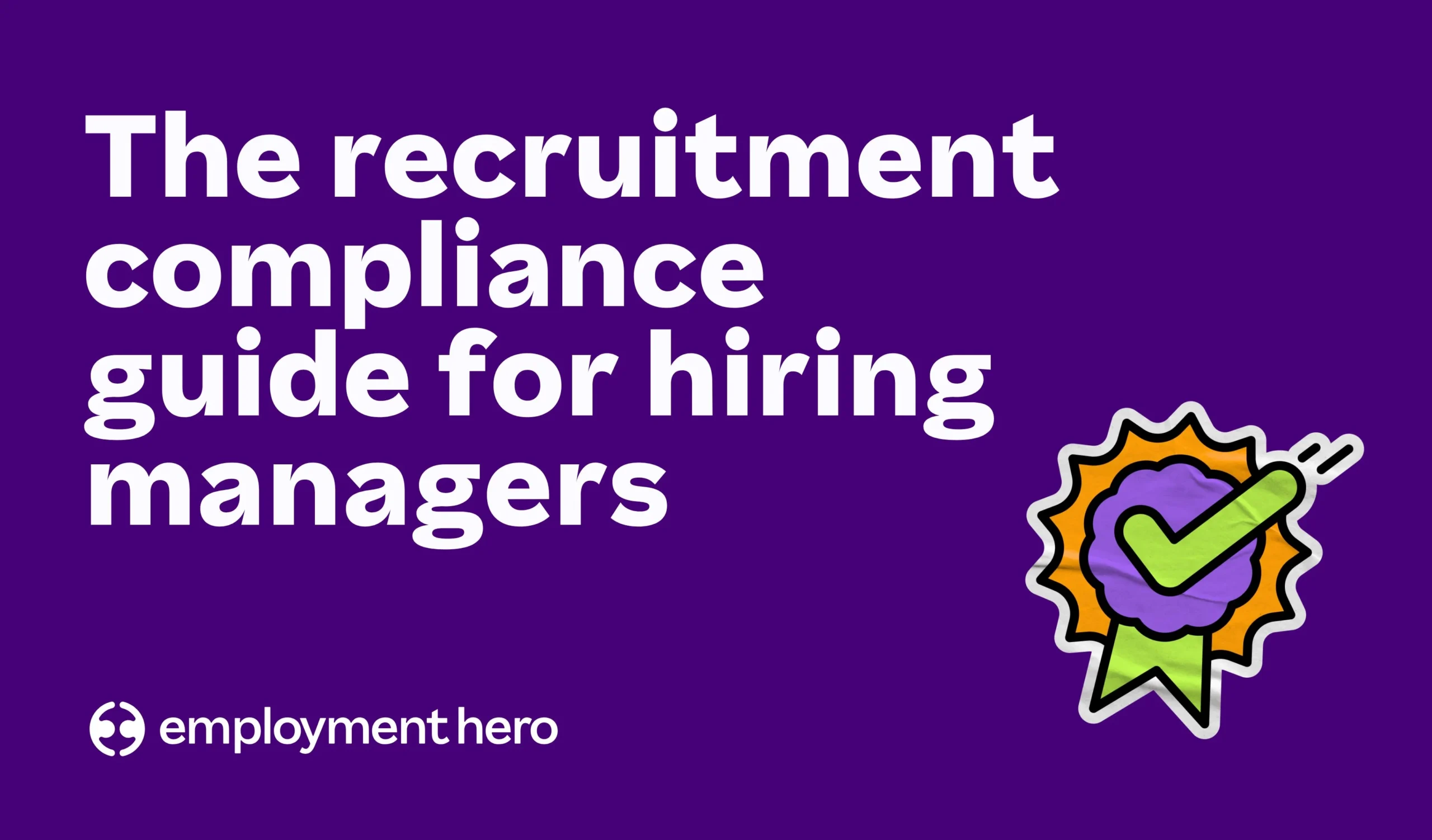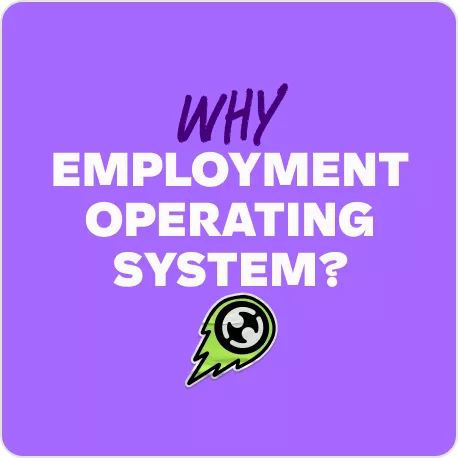A Manager’s Guide To Performance Reviews
Published
A Manager’s Guide To Performance Reviews
What if we told you that times are changing — annual performance reviews are out, and giving regular feedback is in?
As a manager, you’re not only responsible for guiding your team towards success but also for nurturing their individual growth and development. Employee performance reviews play a pivotal role in achieving both of these objectives.
Yet the very mention of performance reviews often triggers mixed feelings among both managers and employees.
But, what if we told you that times are changing? That annual performance reviews are out, and regular feedback is in?
If you’re one of many businesses that are still using outdated methods, we’re here to tell you about a much more effective model that could be transformative for your staff and business.
For a comprehensive approach to conducting successful reviews, consider using our Employee Performance Review Checklist. This checklist will guide you in delivering constructive feedback with confidence.
What’s in the Ultimate Performance Kit?
In this Kit, we’ll cover:
- A more effective way to reflect on performance
- How often you should be discussing performance
- What you should be doing before, during and after a review
- How to give valuable feedback
- Performance, professional development, professional improvement and 1:1 templates
Download the Kit now.
Other resources:
What is a performance review?
A performance review is an assessment with an employee and their direct manager to evaluate performance, define strengths, identify weaknesses, review professional goals and plan for the future.
The goal of a performance review is to use the feedback received for professional improvement and to identify any areas of concern. However, performance reviews are not limited to these areas; they can also include discussions around:
- How the employee is currently progressing towards goals
- How effective their working style is
- Soft skills such as time management and communication
- Attendance, punctuality and behaviour in the workplace
How to conduct a good performance review?
By now it should be clear – a good employee performance review is a well-structured, constructive and objective evaluation of an employee’s job performance and contributions. The review process provides valuable feedback that helps employees understand their strengths, areas for improvement and opportunities for growth.
You’ll know you’ve run a successful employee performance review when you have the following outcomes:
- Clear objectives which focus on specific job-related criteria, such as key performance indicators (KPIs), OKRs or goals and competencies relevant to the employee’s role
- Evidence anddocumentation – As a manager, you should prepare for the review by gathering relevant data and documentation, such as performance metrics, project outcomes and examples of the employee’s work. But remember that the information that comes out during a performance review shouldn’t be a surprise to your employees. Your employees should know how well or how poorly they are doing on an ongoing basis to ensure maximum workplace productivity and to keep an ongoing dialogue about workplace expectations
- Two-way communication – the review should be a two-way conversation, allowing the employee to share their thoughts, concerns and goals
- Constructive feedback that is specific, actionable, and framed in a way that encourages improvement rather than discouragement, highlights achievements and successes, but also addresses areas for development with clarity and sensitivity
- Career pathway or career progression opportunities – the employee is clear about progression and growth opportunities, such as training, workshops or mentoring
- SMART goals which align the employee’s efforts with the organisation’s objectives
- Follow-up and support – after the review, provide ongoing support and follow-up and schedule regular check-ins or one-to-ones to track progress
Most companies will do a performance review at least once every six months – but the more regularly you catch up with your employees, the more on top of things you’ll be and the quicker you’ll know about any issues in the team. Your employees will also feel a lot more loved, knowing that you’re trying to look after them.
A successful performance review process can also lead to more engaged employees, increasing productivity and driving profitability in your business.
How often should performance reviews be conducted?
Once upon a time, performance reviews were held annually, with no other form of review or feedback process throughout the year. And while we say once upon a time, the reality is that many organisations are still using this cadence. This means that there are millions of employees out there feeling left in the dark when it comes to their performance.
When conducted alone once per year, review meetings aren’t an effective tool to determine an employee’s performance. They need to be used in conjunction with other meetings like 1:1s, 360 feedback and more, but we go into that in more detail in the Ultimate Performance Kit.
Download the Kit now.
Ultimately, when it comes to determining the cadence of your teams’ performance reviews, you need to find what works best for you and your organisation.
There are a few things to consider:
- Are managers holding weekly 1:1s with their direct reports?
- Does your company culture embrace feedback?
- Is the current review structure and cadence working for your team?
- Does your team want more feedback?
No matter what you choose, you should continually embrace a culture of regular feedback and employee/manager catch-ups. Not only can it improve communication, performance and overall engagement, it can also make sure that no surprises occur during your performance reviews. If you don’t give your team regular feedback, you’re missing out on vital opportunities for professional development that will only propel your workforce forward.

Why are quarterly reviews better than annual reviews?
As well as one-on-ones, another way to provide progressive feedback is to establish a quarterly performance review.
Working in addition to annual reviews, quarterly reviews (which our performance review system allows) enable more frequent feedback and discussion and give more opportunities for timely recognition of wins and high performance.
Learn more about the benefits of quarterly reviews and other progressive feedback methods in our Performance Review Bundle.
Annual reviews in isolation are also known to create stress and anxiety for employees. Annual reviews that ask long questions requiring essay-like responses are being scrapped in favour of shorter questions in quarterly performance reviews.
This style of progressive performance review creates less stress and elicits a better response from employees.
Why give progressive feedback on employee performance?
Making performance evaluation a natural part of how you work means employees will speak up when they’re struggling or seek help earlier in the process. This proactive approach is more beneficial than waiting until the formal review process comes around.
A company doing progressive performance reviews – the right way
As one of the first companies to make a move to more progressive employment reviews, Adobe famously ditched its traditional employee performance reviews in favour of a check-in model.
In their new model, managers set clear expectations for employees and give progressive performance feedback at a time that suits the employee and the role they perform. This allows managers to make micro-adjustments based on past performance throughout the working year.
In the first year of this shift, the software giant estimated it saved 80,000 manager hours, the equivalent of 40 full-time employees. At the same time, the company could demonstrate higher employee engagement and retention.
How do you create an effective performance review process?
Before we dive in, it’s important to remember that no matter how you design them or how often you hold them, performance evaluations are a two-way street and most definitely a collaborative experience.
So let’s look at seven simple steps to creating an effective performance process.
Pro tip: Prepare for performance reviews with our performance review template
1. Notify employees about performance reviews in advance
Make sure that your employees know that you will be conducting a performance review and tell them on which date it will be happening.
When your employee is mentally prepared for a performance conversation, they may look into how productive they’ve been. This self-evaluation might spark interest in them to do their best in the workplace at all times.
A recent survey from the Society for Human Resource Management found that 72% of organisations conduct formal performance appraisals only once a year, whilst only 2% of employees gave their employer an A grade for their performance management.
2. Have a specific goal
You need to make sure that you know what you will be accomplishing in this meeting. Does your employee need to improve upon certain skills? Do they need a raise? Should they take a break for a while?
Prepare yourself and your employee before the performance review and come up with specific, value-driven advice and issues to discuss beforehand.
If there are forms or feedback that need to be documented, ensure you or the employee has filled these out before the performance review meeting.
Don’t lump all of your employees into the same review system or checklist. Each employee’s work performance will differ and so should your review of them.
3. Have a meeting agenda ready
The best way to guarantee that both managers and employees are prepared is to create a meeting agenda and send it across to them a few days before the performance review meeting.
As a starting point, it’s important to take a look back at the employee’s past performance and work record and look for areas where the employee’s performance can be improved. Make sure you take your time before the review to look over that individual employee’s work over the last 3-6 months – not just recent events.
You should also ask your employee if there’s anything they’d like to discuss and include that on the agenda as well. They may also have questions for you when you bring up any notes of poor performance, so be ready for that too.
Having a set agenda also means that there will be some rough structure to the review meeting, you’ll both get more out of it and it’ll be easier for you to keep a record of everything that’s discussed. Formalising the review process will help to set clear expectations, so nothing shocks or discourages your employee. The last thing you want is for them to feel like they’re being ambushed.
Some of the most important points to cover during a performance review and to include in your agenda are:
- Do the employee’s day-to-day actions align with your business objectives?
- Is the employee held accountable for their duties and expectations?
- Are there documents to support your employee’s work habits?
- Does the employee need to be recognised or awarded for performing well?
- Is the employee compensated clearly and fairly for their work initiatives?
4. Have a positive attitude
When discussing ways to improve performance, you don’t want to overwhelm a staff member with negativity and criticism; that’ll just leave them feeling uncomfortable, unhappy and completely undervalued. And we all know that’s not good for business and can lead to higher staff turnover and a disengaged workforce.
Remember to talk about the positives, and thank your employee for their hard work or any particular projects they’ve worked on. When discussing room for improvement or future performance expectations, make sure you are being as constructive as possible.
How can you work together to resolve a particular problem? What could you or they do differently to make sure that the problem doesn’t keep happening?
Work together with your employee to come up with solutions to any problems or concerns so that they don’t feel like they’re being bombarded with complaints about their performance.

5. Honesty is the best policy
Always be open and honest with all of your employees and your first step, whether during the performance review or not, should be to discuss any issues directly with them.
They may not even know what they’ve been doing wrong, so bringing this up in a formal setting such as a performance review gives them a floor to voice their opinion on the matter and also gives them some time afterwards to resolve any setbacks.
To get a truly effective performance review, make sure you ask your employee to be completely honest too. As managers, you need to make sure that you’re supporting them fully and that you’re providing space for employees to be honest.
- Is there anything I can do to support you more?
- Is there any training or guidance you’d like to take part in?
- Is there anything you’re not happy about?
Keeping an open line of communication like this will help employees to feel valued, listened to and more secure in their work environment. It also means they’ll approach you more readily in the future.
To reinforce this, you could also send out an anonymous employee satisfaction survey to your team. Show that you care about your employees, value their input and care about their happiness. In turn, they’re likely to perform better and care much more about your business.
6. Make it a collaborative process
When you are conducting a performance review, make sure that it’s not a one-way conversation and that you are open to your employees feedback and concerns.
Try not to leave any questions or problems unresolved and instead, come up with a plan or solution that has actionable goals and timelines.
Focus on SMART goal setting: (Specific, Measurable, Attainable, Relevant, Timely.)
It’s also important that you can discuss a future-focused plan together.
Does the employee need to work a little harder? Let them know that you will be monitoring their performance a little more closely and give them dates as to when they can expect a future performance review. Maybe your employee has been asking for a raise; this would be a great time to let them know if and when that could come to fruition and discuss why or why not.
After the performance review has taken place, make sure that your employees understand what has been discussed at the meeting. Let them summarise their thoughts about the meeting and make sure that they don’t leave with any questions unanswered.
Remember, this meeting should be for the benefit of both the employer and the employee. So remember to ask if they have any questions.
7. Talk about career development
People want to know that they have opportunities to progress, grow, challenge themselves and thrive with your company. Your employee performance review is the perfect time to discuss the plan in place for employee development.
Make sure you’re openly asking them what they hope for in the future at that company.
Are they happy in their current role? Would they benefit from further training or learning opportunities? You need to know whether your staff members are happy.
If a staff member does come to you with a progression plan, you may not be able to offer everything to everyone; if the opportunity doesn’t exist, it doesn’t exist. But make sure you come up with an action plan either way.
For example, if it’s not something your company can offer, try to think of other ways to offer them more responsibility, training and development. Show them that you value them and want to keep them around.
Bonus tip – make sure performance reviews happen
Pretty self-explanatory – right? Unfortunately, for one reason or another, there are still a huge number of managers out there who refuse or forget to do regular performance reviews.
There are many benefits of doing regular performance reviews with your team:
- You’ll be much better informed about the way things are at your company.
- You get the chance to set your expectations for staff, so there’s more clarity within your team.
- Employee recognition opportunities.
- Performance reviews allow you to discuss any issues in a professional, formal setting.
- As a manager, you gain insight into how happy your employees are.
- Together with your employee, you’ll find ways to improve their performance.
- Employees will feel more secure, valued and included in your team and will be happier and more productive workers!
Productive performance reviews can amount to a happier, more engaged and more productive workforce. What more could you want?

How to provide feedback after performance reviews
Don’t let the open-ended discussion end in the performance review meeting. It’s a two-way street, after all.
So let your employees know that they can come to you at any time with any concerns that they may have. Discuss which method works best for you to respond on time (i.e. via email, meeting or phone conversation).
And remember that providing feedback after performance reviews is a critical step in the process to ensure that employees understand their performance, have clear expectations moving forward and feel supported in their growth and development.
So after the performance review, schedule a one-to-one meeting with the employee to discuss the feedback. Begin with positives, highlighting their strengths and achievements. Offer specific and constructive feedback on areas for improvement and encourage their input to help set clear expectations for the future. Discuss development opportunities and address any concerns or challenges they may have.
Always stay positive and supportive throughout the conversation, ending on an encouraging note. Remind your employees, if needed, that your door is always open and that you encourage the conversation to keep going – continuous feedback is key to empowering employees and helping them grow professionally.
Provide constructive feedback
To provide constructive feedback effectively, be specific about the behaviours you want to address, and focus on actions, not personalities. Curious about how that sounds in practice?
- Use “I” statements to express your observations to avoid sounding accusatory
- Strike a balance between highlighting strengths and suggesting areas for improvement
- Offer solutions and create a safe space for a conversation
- Listen actively to your employee’s perspective, show respect, and offer support to help them grow
- Collaboratively set clear goals, and regularly follow up to provide ongoing feedback and encouragement
Turn negative performance evaluations into actionable goals
While we know providing feedback can be challenging, it really does present a valuable opportunity for growth and development. As a manager, you can approach these situations with a growth mindset, seeking to understand the underlying issues through open and honest conversations.
With your employee, aim to collaboratively set specific and attainable goals that focus on behaviours and actions, ensuring they align with the employee’s strengths and areas for improvement. Make sure that your employee knows that you’re on hand to provide the necessary support and resources to help them succeed. Encourage them to own their growth and track progress regularly with ongoing feedback. Don’t forget to recognise and celebrate efforts along the way.
Remember, as a manager, your role is to guide employees towards success and create a positive work environment that fosters continuous growth.So even when negative performance evaluations are on the horizon, you can rest knowing how you can turn them into positive opportunities!
How should managers handle negative feedback during reviews?
It’s never nice to get negative feedback, but it can and does happen. The key to handling negative feedback during performance reviews is to take an empathetic, supportive and constructive approach.
If you’re delivering the feedback, make sure that before the review, you’re fully prepared by understanding the concerns and gathering specific examples. When raising the feedback, start with positives to set a positive tone, and then present negative feedback objectively, focusing on job-related aspects rather than focusing on your employee’s character.
Leave room to actively listen to the employee’s perspective, and always avoid being defensive. Be ready to offer practical solutions and resources to help them improve, and emphasise that negative feedback is an opportunity for development and that you and the business support their improvement. Always wrap up the review on an encouraging note rather than ending it on negative points, reaffirming your belief in their potential and commitment to their success.
And if you receive negative feedback from your team? Approach it with an open mind and a willingness to listen and learn. Embrace constructive criticism as an opportunity for your own growth and development. Engage in open discussions with your team to understand their concerns and work collaboratively towards improving the overall work environment and team dynamics.
Being receptive to feedback sets a positive example for your team and strengthens the trust they have in your leadership.
Should performance reviews be used for promotions or salary raises?
Performance reviews can serve as valuable input for promotions and salary raises, but they should not be the sole determining factor. Instead, performance reviews should be one component of a comprehensive evaluation process that considers various factors, such as skills, experience, achievements, average salaries, and contributions to the organisation.
That being said, performance reviews can be used to identify high performers as well as recognising achievements and contributions, which may be relevant to salary reviews.
Do it all with our performance management software
Are you leveraging online tools to get the most out of performance reviews for your whole business?
Because, let’s be honest, if you’re still using a paper-based system, it’s likely to be an extremely painful process for all involved. That means someone needs to spend unnecessary time digging out paperwork, making appointments and sending out email chasers to managers to get the ball rolling.
We’re delighted to tell you that you can forget all that with an online system.
Upgrade your performance reviews with Employment Hero and say goodbye to paper-based headaches—go digital for real-time reports, easy follow-ups and a complete performance picture. Keep track of notes throughout the year, access data anytime and watch your business thrive. Say cheerio to the old ways and embrace efficiency and enhanced performance with online performance reviews.
So if you’re looking for an all-in-one people management platform to help manage your performance reviews, Employment Hero can help.
Download our Ultimate Performance Kit now to get expert tips on managing performance in the workplace.

Related Resources
-
 Read more: Recruitment compliance guide for hiring managers
Read more: Recruitment compliance guide for hiring managersRecruitment compliance guide for hiring managers
Learn how to manage compliance when finding talent and interviewing candidates in your business.
-
 Read more: Hiring issues holding you back? The business owner’s guide to competing for top talent
Read more: Hiring issues holding you back? The business owner’s guide to competing for top talentHiring issues holding you back? The business owner’s guide to competing for top talent
Published Hiring great people is one of the most powerful ways to grow your business – but it can also…













